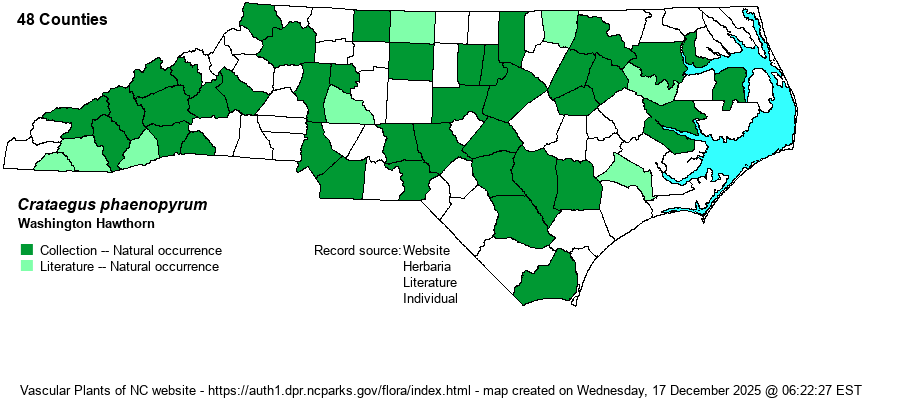| Author | (L. fils) Medikus | |
| Distribution | Scattered over nearly all of the state, from the Mountains to the eastern Coastal Plain, but still only a few dozen of these counties with specimen records. Perhaps genuinely absent in most coastal counties, though there are records in coastal counties nearby in VA and SC.
This is a widespread Eastern species from PA west to MO, and south to the FL Panhandle and MS. Records in other states may be escapes from plantings.
| |
| Abundance | Generally uncommon or infrequent across the state, and probably rare in the far eastern counties. It seems to be nowhere common in NC, though possibly more numerous in the Mountains than farther east. | |
| Habitat | This is a wetland species in its original native habitat, found mainly in bottomland forests, but also along wooded stream banks and in swamps. Its presence in upland areas might be escapes from cultivation, as it is not rare in upland pastures and wooded edges, at least in the mountains. | |
| Phenology | Blooms from May to early June, about the latest flowering hawthorn in our area. Fruits from September to October. | |
| Identification | This is a small tree, with a single trunk, and often reaching 20 feet tall. It has rather distinctive leaves for a hawthorn in NC, they being quite triangular in shape, with a hastate/squared-off base and typically three major maple-like lobes. Some leaves look quite similar to those of Red Maple (Acer rubrum). There are numerous flowers in an inflorescence, and flowering can often be profuse, frequently into early June at higher elevations. The rather small red fruit often remain on the trees into the winter. This species theoretically could be seen by an observer in nearly every county in the state; however, it is infrequent enough that one may go several years without seeing it, unless he/she goes to known locations or unless he/she carefully studies every hawthorn encountered. | |
| Taxonomic Comments | None. This is one of the relatively few hawthorns that has been accepted by essentially all references since it was described in 1782.
| |
| Other Common Name(s) | Washington Thorn | |
| State Rank | S3 [S4] | |
| Global Rank | G4? | |
| State Status | | |
| US Status | | |
| USACE-agcp | FAC link |
| USACE-emp | FAC link |

